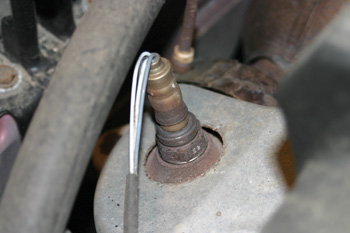A bad oxygen sensor is one of the most common reasons for failing an emissions test, according to EPA research. Most oxygen sensors do not have a scheduled service interval and are only replaced if they have failed or are causing a drivability, fuel economy or emissions problem. A bad sensor should set a fault code and turn on the Check Engine light, but sometimes they don’t so the motorist has no way of knowing a sensor may have to be replaced. And even if the Check Engine light is on and there’s an oxygen sensor code, it doesn’t always mean the sensor is bad. Some O2 sensor codes (such as rich or lean codes) can be caused by other conditions such as dirty, leaky or inoperative fuel injectors, air/vacuum leaks, ignition misfires, exhaust leaks and so on. Because of this, accurate diagnosis is important to make sure an oxygen sensor actually needs to be replaced.
 Many technicians recommend replacing all of the oxygen sensors in a high-mileage vehicle if one of the O2 sensors has failed. If contaminants such as oil or coolant enter the combustion chamber, it can foul any or all of the O2 sensors.
Many technicians recommend replacing all of the oxygen sensors in a high-mileage vehicle if one of the O2 sensors has failed. If contaminants such as oil or coolant enter the combustion chamber, it can foul any or all of the O2 sensors.
The response time of O2 sensors can slow down with age. A sensor also may become biased rich or lean (usually lean), causing a drop in fuel economy and an increase in emissions. Replacing a sluggish or biased O2 sensor will restore like-new performance.
Many technicians prefer to install “exact fit” replacement sensors because they are faster and easier to install and save the time and trouble of having to cut and slice the sensor harness wiring. Universal fit oxygen sensors are usually less expensive than exact fit O2 sensors, and reduce inventory requirements by allowing fewer SKUs to cover a broader range of applications. But universal fit O2 sensors do require a little more effort to install.
Upstream O2 sensors are located in the engine’s exhaust manifold(s) while the downstream O2 sensor is located in or behind the catalytic converter. The upstream O2 sensors monitor the air/fuel mixture oxygen levels coming out of the engine while the downstream sensor monitors the operating efficiency of the catalyst.
Replacing an oxygen sensor may be difficult depending on the sensor’s location. Your customer may need a special, deep-well O2 sensor socket to replace the sensor. The threads on most new O2 sensors have a coating to minimize corrosion. A small dab of antiseize can be applied to the threads to prevent sticking, but care must be used to keep the compound away from the sensor tip so it doesn’t foul the new sensor.












